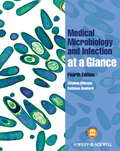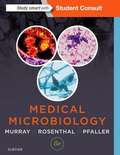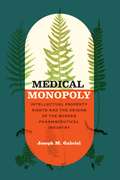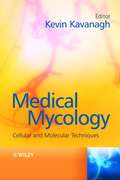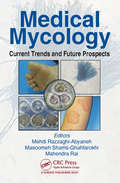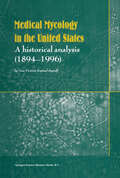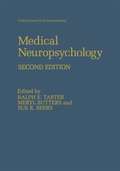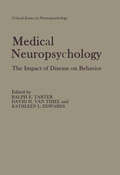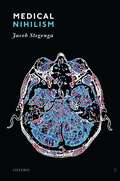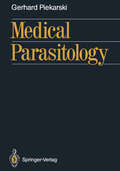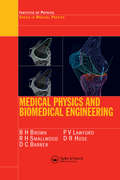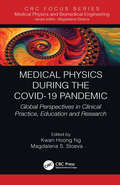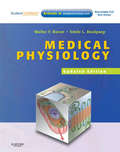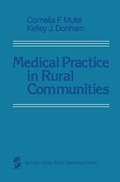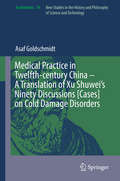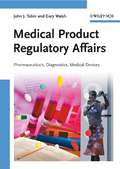- Table View
- List View
Medical Microbiology and Infection at a Glance (At a Glance #76)
by Stephen Gillespie Kathleen BamfordThis concise and popular introduction to medical microbiology and infection encapsulates the fundamental facts and principles of this rapidly growing and changing subject area. Written by experienced clinicians and teachers, it covers the basic concepts of medical microbiology, and the main human pathogens and infectious syndromes, in an accessible and lucid format. This fully updated fourth edition is now supported by a companion website at www.ataglanceseries.com/medicalmicrobiology containing extra self-assessment cases, colour slides, further reading, and key point summaries. Medical Microbiology and Infection at a Glance is an invaluable revision aid for medical and allied health students and junior doctors, and is ideal for anyone seeking a comprehensive and concise guide to this subject area.
Medical Microbiology and Infection at a Glance (At a Glance #74)
by Stephen Gillespie Kathleen BamfordThis concise and popular introduction to medical microbiology and infection encapsulates the fundamental facts and principles of this rapidly growing and changing subject area. Written by experienced clinicians and teachers, it covers the basic concepts of medical microbiology, and the main human pathogens and infectious syndromes, in an accessible and lucid format. This fully updated fourth edition is now supported by a companion website at www.ataglanceseries.com/medicalmicrobiology containing extra self-assessment cases, colour slides, further reading, and key point summaries. Medical Microbiology and Infection at a Glance is an invaluable revision aid for medical and allied health students and junior doctors, and is ideal for anyone seeking a comprehensive and concise guide to this subject area.
Medical Microbiology (PDF)
by Patrick R. Murray Ken S. Rosenthal Michael A. PfallerTurn to Medical Microbiology, 8th Edition for a thorough, clinically relevant understanding of microbes and their diseases. This succinct, easy-to-use text presents the fundamentals of microbiology and immunology in a clearly written, engaging manner-effectively preparing you for your courses, exams, and beyond. Coverage of basic principles, immunology, laboratory diagnosis, bacteriology, virology, mycology, and parasitology help you master the essentials. Review questions at the end of each chapter correlate basic science with clinical practice to help you understand the clinical relevance of the organisms examined. Clinical cases illustrate the epidemiology, diagnosis, and treatment of infectious diseases, reinforcing a clinical approach to learning. Full-color clinical photographs, images, and illustrations help you visualize the clinical presentations of infections. Summary tables and text boxes emphasizing essential concepts and learning issues optimize exam review. Additional images, 200 self-assessment questions, NEW animations, and more. Student Consult eBook version included with purchase. This enhanced eBook experience includes access -- on a variety of devices -- to the complete text, videos, images, and references from the book. Thoroughly updated chapters include the latest information on the human microbiome and probiotics/prebiotics; including a new chapter on Human Microbiome In Health and Disease. NEW chapter summaries introduce each microbe chapter, including trigger words and links to the relevant chapter text (on e-book version on Student Consult), providing a concise introduction or convenient review for each topic. Online access to the complete text, additional images, 200 self-assessment questions, NEW animations, and more is available through Student Consult. 9780323359528
Medical Monopoly: Intellectual Property Rights and the Origins of the Modern Pharmaceutical Industry (Synthesis)
by Joseph M. GabrielDuring most of the nineteenth century, physicians and pharmacists alike considered medical patenting and the use of trademarks by drug manufacturers unethical forms of monopoly; physicians who prescribed patented drugs could be, and were, ostracized from the medical community. In the decades following the Civil War, however, complex changes in patent and trademark law intersected with the changing sensibilities of both physicians and pharmacists to make intellectual property rights in drug manufacturing scientifically and ethically legitimate. By World War I, patented and trademarked drugs had become essential to the practice of good medicine, aiding in the rise of the American pharmaceutical industry and forever altering the course of medicine. Drawing on a wealth of previously unused archival material, Medical Monopoly combines legal, medical, and business history to offer a sweeping new interpretation of the origins of the complex and often troubling relationship between the pharmaceutical industry and medical practice today. Joseph M. Gabriel provides the first detailed history of patent and trademark law as it relates to the nineteenth-century pharmaceutical industry as well as a unique interpretation of medical ethics, therapeutic reform, and the efforts to regulate the market in pharmaceuticals before World War I. His book will be of interest not only to historians of medicine and science and intellectual property scholars but also to anyone following contemporary debates about the pharmaceutical industry, the patenting of scientific discoveries, and the role of advertising in the marketplace.
Medical Monopoly: Intellectual Property Rights and the Origins of the Modern Pharmaceutical Industry (Synthesis)
by Joseph M. GabrielDuring most of the nineteenth century, physicians and pharmacists alike considered medical patenting and the use of trademarks by drug manufacturers unethical forms of monopoly; physicians who prescribed patented drugs could be, and were, ostracized from the medical community. In the decades following the Civil War, however, complex changes in patent and trademark law intersected with the changing sensibilities of both physicians and pharmacists to make intellectual property rights in drug manufacturing scientifically and ethically legitimate. By World War I, patented and trademarked drugs had become essential to the practice of good medicine, aiding in the rise of the American pharmaceutical industry and forever altering the course of medicine. Drawing on a wealth of previously unused archival material, Medical Monopoly combines legal, medical, and business history to offer a sweeping new interpretation of the origins of the complex and often troubling relationship between the pharmaceutical industry and medical practice today. Joseph M. Gabriel provides the first detailed history of patent and trademark law as it relates to the nineteenth-century pharmaceutical industry as well as a unique interpretation of medical ethics, therapeutic reform, and the efforts to regulate the market in pharmaceuticals before World War I. His book will be of interest not only to historians of medicine and science and intellectual property scholars but also to anyone following contemporary debates about the pharmaceutical industry, the patenting of scientific discoveries, and the role of advertising in the marketplace.
Medical Monopoly: Intellectual Property Rights and the Origins of the Modern Pharmaceutical Industry (Synthesis)
by Joseph M. GabrielDuring most of the nineteenth century, physicians and pharmacists alike considered medical patenting and the use of trademarks by drug manufacturers unethical forms of monopoly; physicians who prescribed patented drugs could be, and were, ostracized from the medical community. In the decades following the Civil War, however, complex changes in patent and trademark law intersected with the changing sensibilities of both physicians and pharmacists to make intellectual property rights in drug manufacturing scientifically and ethically legitimate. By World War I, patented and trademarked drugs had become essential to the practice of good medicine, aiding in the rise of the American pharmaceutical industry and forever altering the course of medicine. Drawing on a wealth of previously unused archival material, Medical Monopoly combines legal, medical, and business history to offer a sweeping new interpretation of the origins of the complex and often troubling relationship between the pharmaceutical industry and medical practice today. Joseph M. Gabriel provides the first detailed history of patent and trademark law as it relates to the nineteenth-century pharmaceutical industry as well as a unique interpretation of medical ethics, therapeutic reform, and the efforts to regulate the market in pharmaceuticals before World War I. His book will be of interest not only to historians of medicine and science and intellectual property scholars but also to anyone following contemporary debates about the pharmaceutical industry, the patenting of scientific discoveries, and the role of advertising in the marketplace.
Medical Monopoly: Intellectual Property Rights and the Origins of the Modern Pharmaceutical Industry (Synthesis)
by Joseph M. GabrielDuring most of the nineteenth century, physicians and pharmacists alike considered medical patenting and the use of trademarks by drug manufacturers unethical forms of monopoly; physicians who prescribed patented drugs could be, and were, ostracized from the medical community. In the decades following the Civil War, however, complex changes in patent and trademark law intersected with the changing sensibilities of both physicians and pharmacists to make intellectual property rights in drug manufacturing scientifically and ethically legitimate. By World War I, patented and trademarked drugs had become essential to the practice of good medicine, aiding in the rise of the American pharmaceutical industry and forever altering the course of medicine. Drawing on a wealth of previously unused archival material, Medical Monopoly combines legal, medical, and business history to offer a sweeping new interpretation of the origins of the complex and often troubling relationship between the pharmaceutical industry and medical practice today. Joseph M. Gabriel provides the first detailed history of patent and trademark law as it relates to the nineteenth-century pharmaceutical industry as well as a unique interpretation of medical ethics, therapeutic reform, and the efforts to regulate the market in pharmaceuticals before World War I. His book will be of interest not only to historians of medicine and science and intellectual property scholars but also to anyone following contemporary debates about the pharmaceutical industry, the patenting of scientific discoveries, and the role of advertising in the marketplace.
Medical Monopoly: Intellectual Property Rights and the Origins of the Modern Pharmaceutical Industry (Synthesis)
by Joseph M. GabrielDuring most of the nineteenth century, physicians and pharmacists alike considered medical patenting and the use of trademarks by drug manufacturers unethical forms of monopoly; physicians who prescribed patented drugs could be, and were, ostracized from the medical community. In the decades following the Civil War, however, complex changes in patent and trademark law intersected with the changing sensibilities of both physicians and pharmacists to make intellectual property rights in drug manufacturing scientifically and ethically legitimate. By World War I, patented and trademarked drugs had become essential to the practice of good medicine, aiding in the rise of the American pharmaceutical industry and forever altering the course of medicine. Drawing on a wealth of previously unused archival material, Medical Monopoly combines legal, medical, and business history to offer a sweeping new interpretation of the origins of the complex and often troubling relationship between the pharmaceutical industry and medical practice today. Joseph M. Gabriel provides the first detailed history of patent and trademark law as it relates to the nineteenth-century pharmaceutical industry as well as a unique interpretation of medical ethics, therapeutic reform, and the efforts to regulate the market in pharmaceuticals before World War I. His book will be of interest not only to historians of medicine and science and intellectual property scholars but also to anyone following contemporary debates about the pharmaceutical industry, the patenting of scientific discoveries, and the role of advertising in the marketplace.
Medical Monopoly: Intellectual Property Rights and the Origins of the Modern Pharmaceutical Industry (Synthesis)
by Joseph M. GabrielDuring most of the nineteenth century, physicians and pharmacists alike considered medical patenting and the use of trademarks by drug manufacturers unethical forms of monopoly; physicians who prescribed patented drugs could be, and were, ostracized from the medical community. In the decades following the Civil War, however, complex changes in patent and trademark law intersected with the changing sensibilities of both physicians and pharmacists to make intellectual property rights in drug manufacturing scientifically and ethically legitimate. By World War I, patented and trademarked drugs had become essential to the practice of good medicine, aiding in the rise of the American pharmaceutical industry and forever altering the course of medicine. Drawing on a wealth of previously unused archival material, Medical Monopoly combines legal, medical, and business history to offer a sweeping new interpretation of the origins of the complex and often troubling relationship between the pharmaceutical industry and medical practice today. Joseph M. Gabriel provides the first detailed history of patent and trademark law as it relates to the nineteenth-century pharmaceutical industry as well as a unique interpretation of medical ethics, therapeutic reform, and the efforts to regulate the market in pharmaceuticals before World War I. His book will be of interest not only to historians of medicine and science and intellectual property scholars but also to anyone following contemporary debates about the pharmaceutical industry, the patenting of scientific discoveries, and the role of advertising in the marketplace.
Medical Mycology: Cellular and Molecular Techniques
by Kevin KavanaghMedical Mycology: Cellular and Molecular techniques is a clear and concise overview of the subject that details the techniques essential for ongoing research in the area. Drawing together contributions from both scientists and clinicians working in the field, the text will provide a valuable perspective on the applicability of specific techniques to patient care. A wide range of molecular, immunological and cytological techniques are discussed throughout, with the inclusion of protocol section in each chapter designed to provide both a background a up-to-date account of the applications of each procedure. Every technique is fully referenced and illustrations are provided where required to enhance student understanding. comprehensive introduction to the key techniques critical to the study of medical mycology clear explanation of how each technique is applied in the lab contributions from internationally recognised experts in the field outlines the background to many techniques required for the successful completion of a research project An invaluable reference for students of microbiology, biochemistry and molecular biology as well as postgraduates and researchers in the field of medical mycology looking for an up-to-date overview of the latest laboratory techniques.
Medical Mycology: Current Trends and Future Prospects
by Mehdi Razzaghi-Abyaneh Masoomeh Shams-Ghahfarokhi Mahendra RaiThe identification of medically important fungi has been an important area of study that warrants further extensive research. The use oftraditional and molecular methods of identification, provides new insights into differentiation of species and ultimately the line of treatment can be determined. This book incorporates a diverse group of medically
Medical Mycology in the United States: A Historical Analysis (1894–1996)
by Ana Victoria Espinell-IngroffMedical Neuropsychology: Second Edition (Critical Issues in Neuropsychology)
by Sue R. Beers Meryl A. Butters Ralph E. TarterMedical Neuropsychology: The Impact of Disease on Behavior (Critical Issues in Neuropsychology)
by Ralph E. Tarter, David H. Thiel and Kathleen L. EdwardsGreat strides have been made in the past several decades in clarifying brain behavior relationships. Most of the research has focused on the direct effects of a brain injury on behavioral functioning. Only recently has attention been given to documenting the mechanisms by which the disruption of various organs and systems compromise cerebral integrity and ultimately how such disruption affects cognition and behavior. It is this relatively new topic of inquiry, medical neuropsychology, that comprises the subject of this book. As will be noted, the chapters are organized on a system-by-system basis. Each of the organ systems contributes in a unique and specialized fashion to maintaining the integrity of brain functioning. Thus, the chapters by Prigatano and Levin, Stanton, and Ryan address the consequences of disturbed energy regulation and oxygen supply. Other chapters, specifically those by Tarter, Edwards, and Van Thiel and by Hart and Kreutzer examine the effects on the brain when the liver and kidney cannot efficiently cata bolize or eliminate cerebrotoxic substances. The effects of metabolic disrup tion mediated through pituitary and thyroid gland mechanisms illustrate the complex and synergistic relationship among the various organs and systems and the brain. As discussed by Gordon, Lee, and Tamres, diverse intercorre lated processes regulate physical growth, cerebral specialization of function, and complex cognitive capacities. Beckwith and Tucker underscore the in terrelationships among cognitive, affective, behavioral, and neurophysio logical processes pertinent to thyroid functioning. The book concludes with discussions of three rather specialized topics of current interest.
Medical Nihilism
by Jacob StegengaThis book argues that if we consider the ubiquity of small effect sizes in medicine, the extent of misleading evidence in medical research, the thin theoretical basis of many interventions, and the malleability of empirical methods, and if we employ our best inductive framework, then our confidence in medical interventions ought to be low.
Medical Parasitology
by Gerhard PiekarskiMedical Parasitology is primarily intended to be an illustrated textbook which provides a review ofthe most important species ofparasite which occur in man; their areas ofdistribution, morphology and development, the typical disease symptoms resulting from infection, epidemiology and also methods of detection and indications for therapy. The main emphasis is on the protozoan and helmin thic diseases; medical entomology has only been covered in connection with the epidemiology of the diseases described here. Parasites sometimes occur exclusively in man (anthropoparasites) and sometimes also in animals (anthropozoonotic parasites). The monoxenous species complete theirdevelopmentinmanorinoneanimalalone (Scheme I). Heteroxenousspecies, which include most of the medically important parasites, develop partly in man and partly in animals in the course of their life cycle. They may even be forced to infect different species so that they can continue their development. This may sometimes be associated with a digenesis, the larval development taking place in one intermediate (Scheme II ®) or in two different intermediate hosts (Scheme III ®, ©), andthesexuallymaturestagedevelopinginanotherhost, the so-called definitive host (Scheme III ®). The importance of the intermediate hosts can vary considerably (see below).
Medical Physics and Biomedical Engineering (Series in Medical Physics and Biomedical Engineering)
by B. H Brown R. H Smallwood D. C. Barber P. V Lawford D. R HoseMedical Physics and Biomedical Engineering provides broad coverage appropriate for senior undergraduates and graduates in medical physics and biomedical engineering. Divided into two parts, the first part presents the underlying physics, electronics, anatomy, and physiology and the second part addresses practical applications. The structured approach means that later chapters build and broaden the material introduced in the opening chapters; for example, students can read chapters covering the introductory science of an area and then study the practical application of the topic. Coverage includes biomechanics; ionizing and nonionizing radiation and measurements; image formation techniques, processing, and analysis; safety issues; biomedical devices; mathematical and statistical techniques; physiological signals and responses; and respiratory and cardiovascular function and measurement. Where necessary, the authors provide references to the mathematical background and keep detailed derivations to a minimum. They give comprehensive references to junior undergraduate texts in physics, electronics, and life sciences in the bibliographies at the end of each chapter.
Medical Physics and Biomedical Engineering (Series in Medical Physics and Biomedical Engineering)
by B.H Brown R.H Smallwood D.C. Barber P.V Lawford D.R HoseMedical Physics and Biomedical Engineering provides broad coverage appropriate for senior undergraduates and graduates in medical physics and biomedical engineering. Divided into two parts, the first part presents the underlying physics, electronics, anatomy, and physiology and the second part addresses practical applications. The structured approach means that later chapters build and broaden the material introduced in the opening chapters; for example, students can read chapters covering the introductory science of an area and then study the practical application of the topic. Coverage includes biomechanics; ionizing and nonionizing radiation and measurements; image formation techniques, processing, and analysis; safety issues; biomedical devices; mathematical and statistical techniques; physiological signals and responses; and respiratory and cardiovascular function and measurement. Where necessary, the authors provide references to the mathematical background and keep detailed derivations to a minimum. They give comprehensive references to junior undergraduate texts in physics, electronics, and life sciences in the bibliographies at the end of each chapter.
Medical Physics During the COVID-19 Pandemic: Global Perspectives in Clinical Practice, Education and Research (Focus Series in Medical Physics and Biomedical Engineering)
by Kwan Hoong Ng; Magdalena S. StoevaSpreading to every corner of the Earth, the COVID-19 virus has had an unparalleled impact on all aspects of our lives. This book explores in detail how the COVID-19 pandemic has affected clinical practice, education, and research in medical physics, and how colleagues on the frontline dealt with this unpredictable and unprecedented pandemic. It tackles key questions such as: How did medical physicists first respond to the situation? What innovative strategies were taken and how effective were they? How are medical physicists preparing for the future? There will be a focus on the different experiences of regional medical physicists and the responses and outlooks in clinical practice, education, and research in the affected continents, Asia-Pacific, the Middle East, Europe, Africa and North and Latin America. With over 91 contributors from 39 countries, this unique resource contains key perspectives from teams from each territory to ensure a global range of accounts. The collective opinion and wisdom from the major medical physics journal editors-in-chief are also explored, alongside how the pandemic has affected the quantity and quality of publications. Voices of early-career researchers and students of medical physics will be included, with narratives of their experiences coping with life during the pandemic. Lastly, communicating leadership in times of adversity is highlighted. This book will be a historic account of the impact of the COVID-19 virus on the field of medical physics. It will be an ideal reference for medical physicists, medical physics trainees and students, hospital administrators, regulators, and healthcare professionals allied with medical physics. Key features: The first book to cover the impact of COVID-19 on the field of medical physics Edited by two experts in the field, with chapter contributions from subject area specialists around the world Broad, global coverage, ranging from the impact on teaching, research, and publishing, with unique perspectives from journal editors and students and trainees
Medical Physics During the COVID-19 Pandemic: Global Perspectives in Clinical Practice, Education and Research (Focus Series in Medical Physics and Biomedical Engineering)
by Kwan-Hoong Ng Magdalena S. StoevaSpreading to every corner of the Earth, the COVID-19 virus has had an unparalleled impact on all aspects of our lives. This book explores in detail how the COVID-19 pandemic has affected clinical practice, education, and research in medical physics, and how colleagues on the frontline dealt with this unpredictable and unprecedented pandemic. It tackles key questions such as: How did medical physicists first respond to the situation? What innovative strategies were taken and how effective were they? How are medical physicists preparing for the future? There will be a focus on the different experiences of regional medical physicists and the responses and outlooks in clinical practice, education, and research in the affected continents, Asia-Pacific, the Middle East, Europe, Africa and North and Latin America. With over 91 contributors from 39 countries, this unique resource contains key perspectives from teams from each territory to ensure a global range of accounts. The collective opinion and wisdom from the major medical physics journal editors-in-chief are also explored, alongside how the pandemic has affected the quantity and quality of publications. Voices of early-career researchers and students of medical physics will be included, with narratives of their experiences coping with life during the pandemic. Lastly, communicating leadership in times of adversity is highlighted. This book will be a historic account of the impact of the COVID-19 virus on the field of medical physics. It will be an ideal reference for medical physicists, medical physics trainees and students, hospital administrators, regulators, and healthcare professionals allied with medical physics. Key features: The first book to cover the impact of COVID-19 on the field of medical physics Edited by two experts in the field, with chapter contributions from subject area specialists around the world Broad, global coverage, ranging from the impact on teaching, research, and publishing, with unique perspectives from journal editors and students and trainees
Medical Physiology, 2e Updated Edition E-Book: with STUDENT CONSULT Online Access
by Walter F. Boron Emile L. BoulpaepMedical Physiology, in its updated 2nd edition, firmly relates molecular and cellular biology to the study of human physiology and disease. Drs. Walter Boron and Emile Boulpaep and a team of leading physiologists present you with practical, accurate coverage, continually emphasizing the clinical implications of the material. Each chapter explains the principles and organization of each body system, while more than 1400 high-quality, full-color line drawings and prominently featured clinical examples clarify every concept. This exceptionally detailed and comprehensive guide to physiology is ideal for a rich, straightforward, state-of-the-art understanding of this essential subject.Quickly review important content using prominent boxes included throughout the text to provide clinical examples of disordered physiology. Master difficult concepts with the use of 800 color drawings that feature balloon captions explaining key processes. Find information easily with the intuitive organization by body system and consistent style. Get up-to-date coverage of physiology with updated text and figures. Access the fully searchable text online at www.StudentConsult.com, along with Webnotes, Image Bank, 150 Self-assessment questions, and 10 physiology animations. Stay current thanks to updated material, including a new chapter on Physiology of Aging and a new section on hemostasis. Gain a clear visual understanding with a revised and updated art program of high-quality, full color line drawings and prominently featured clinical examples.
Medical Practice in Rural Communities
by MUTELDespite the urbanization of the United States, the rural population exceeds 60 million, and the provision of health services to these people remains a difficult problem. This volume addresses one crucial aspect of that problem-the task of attracting physicians to rural medical practice. It does this by carefully analyzing the special health problems and the general features of rural society in which the young doctor would be working. Rural health needs have been recognized in America for wen over a century. In response, many organized health programs have, in fact, improved the situation. Compared to 1930, the present coverage of rural counties by public health agencies has been greatly extended. Thanks to the Hill-Burton Act of 1946, the availability of general hospital beds has become virtually equalized among the states with varying degrees of rurality. Federally subsidized and locally organized health programs are serving migratory workers, American Indians, the people of Appalachia, and other rural groups. Voluntary health insurance covers millions of rural families, even though the extent of this economic protection is less than among urban families. Medicare helps to protect the rural aged, as it does the urban. Medicaid finances health services for the rural poor far more effectively than the purely local welfare programs of 1930. There is no question, then, about the improvement in rural health resources and services in America over the last 50 years.
Medical Practice in Twelfth-century China – A Translation of Xu Shuwei’s Ninety Discussions [Cases] on Cold Damage Disorders (Archimedes #54)
by Asaf GoldschmidtThis book is an annotated translation of Xu Shuwei’s (1080–1154) collection of 90 medical case records – Ninety Discussions of Cold Damage Disorders (shanghan jiushi lun 傷寒九十論) – which was the first such collection in China. The translation reveals patterns of social as well as medical history. This book provides the readers with a distinctive first hand perspective on twelfth-century medical practice, including medical aspects, such as nosology, diagnosis, treatment, and doctrinal reasoning supporting them. It also presents the social aspect of medical practice, detailing the various participants in the medical encounter, their role, the power relations within the encounter, and the location where the encounter occurred. Reading the translation of Xu’s cases allows the readers high-resolution snapshots of medicine and medical practice as reflected from the case records documented by this leading twelfth-century physician. The detailed introduction to the translation contextualizes Xu’s life and medical practice in the broader changes of this transformative era.
Medical Product Regulatory Affairs: Pharmaceuticals, Diagnostics, Medical Devices
by John J. Tobin Gary WalshWritten in a clear and concise style by an experienced author, this attractively-priced book covers regulatory affairs in all major global markets for pharmaceuticals and medical devices, making it the most comprehensive in its field. Following a look at drug development, complete sections are devoted to national and EU regulatory issues, manufacturing license application and retention, and regulation in the USA. Other topics dealt with include CDER, CBER and marketing and manufacturing licenses, the ICH process and Good Laboratory/Clinical/Manufacturing Practices. Everything pharmacologists, bioengineers, pharma engineers, students in pharmacy and those working in the pharmaceutical industry need to know about medical regulatory affairs.
Medical Product Regulatory Affairs: Pharmaceuticals, Diagnostics, Medical Devices
by John J. Tobin Gary WalshWritten in a clear and concise style by an experienced author, this attractively-priced book covers regulatory affairs in all major global markets for pharmaceuticals and medical devices, making it the most comprehensive in its field. Following a look at drug development, complete sections are devoted to national and EU regulatory issues, manufacturing license application and retention, and regulation in the USA. Other topics dealt with include CDER, CBER and marketing and manufacturing licenses, the ICH process and Good Laboratory/Clinical/Manufacturing Practices. Everything pharmacologists, bioengineers, pharma engineers, students in pharmacy and those working in the pharmaceutical industry need to know about medical regulatory affairs.
